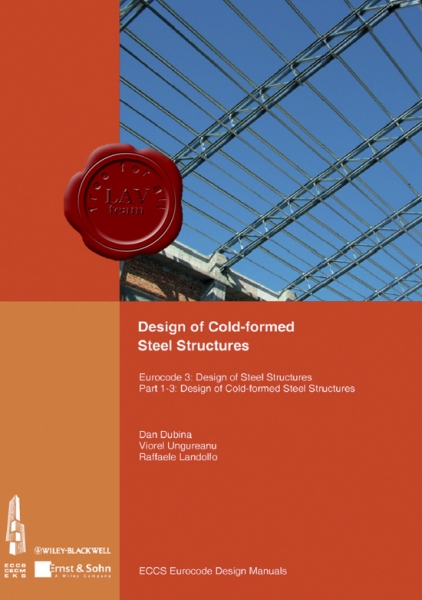| |
Dan Dubina, Viorel Ungureanu, Raffaele Landolfo - Design of Cold-formed Steel Structures
Eurocode 3: Design of Steel Structures
Part 1-3 – Design of Cold-formed Steel Structures
Wiley, 2012
pdf, 676 pages, english
ISBN: 978-3-433-02979-4

Following pioneering research in the 1940s, research into cold-formed steel intensified in the 1970s and led to numerous national European design specifications, and subsequently the preparation of Part 1-3 of Eurocode3 (EN1993-1-3) for cold-formed steel structures. Now a Euronorm, EN1993-1-3 is fully embedded in the Eurocode framework. This book serves as a reference text for design engineers using EN1993-1-3. It forms part of the suite of ECCS Eurocode Design Manuals prepared in recent years for other parts of EN1993 and other Eurocodes to aid the implementation of Eurocodes in European states. The book draws on the authors’ considerable experience with designing cold-formed steel structures, both as academics and practitioners, and strikes a balance between theory and practice. Applications of cold-formed steel have broadened over the years. Coldformed steel is now used as primary structural elements, as in steel framed residential buildings, steel storage racks, portal frames, and tubular truss and frame structures, and as secondary structural elements, as in roofing and wall systems featuring purlins, girts and corrugated steel sheeting. Additionally, integrated building systems have been developed, such as cassettes, as have stressed skin principles for designing the building envelope. The design of cold-formed steel is perceived to be challenging by many structural engineers because the thinness of the steel leads to buckling and failure modes not found in the design of hot-rolled and fabricated steel structures. Furthermore, roll-forming techniques have developed rapidly in recent decades and spawned highly optimised cross sections featuring intermediate stiffeners and complex lip stiffeners, which are not easily designed using conventional methods. The book covers the design of structural members of complex shapes and connections as well as the design of integrated structural solutions, such as cassettes, and design using stressed skin principles. The structural behaviour and design to EN1993-1-3 are explained and numerous worked examples are included to guide or enable a cross-check for structural design engineers. The final Chapter 8 deserves a special mention as it addresses the comprehensive range of considerations other than structural to be made in cold-formed steel construction, including thermal transmission and sound, serviceability, durability, sustainability and recyclability. Methods of design for single and multi-storey housing are explained in detail, concluding with a comprehensive worked example of a residential building. This book presents a landmark in the development of guidelines for the structural design of cold-formed steel. It is arguably the most extensive reference available for designing cold-formed steel structures to EN1993-1-3, and will serve the structural engineering community well in adapting to the expanding range of residential and industrial applications of cold-formed steel. |